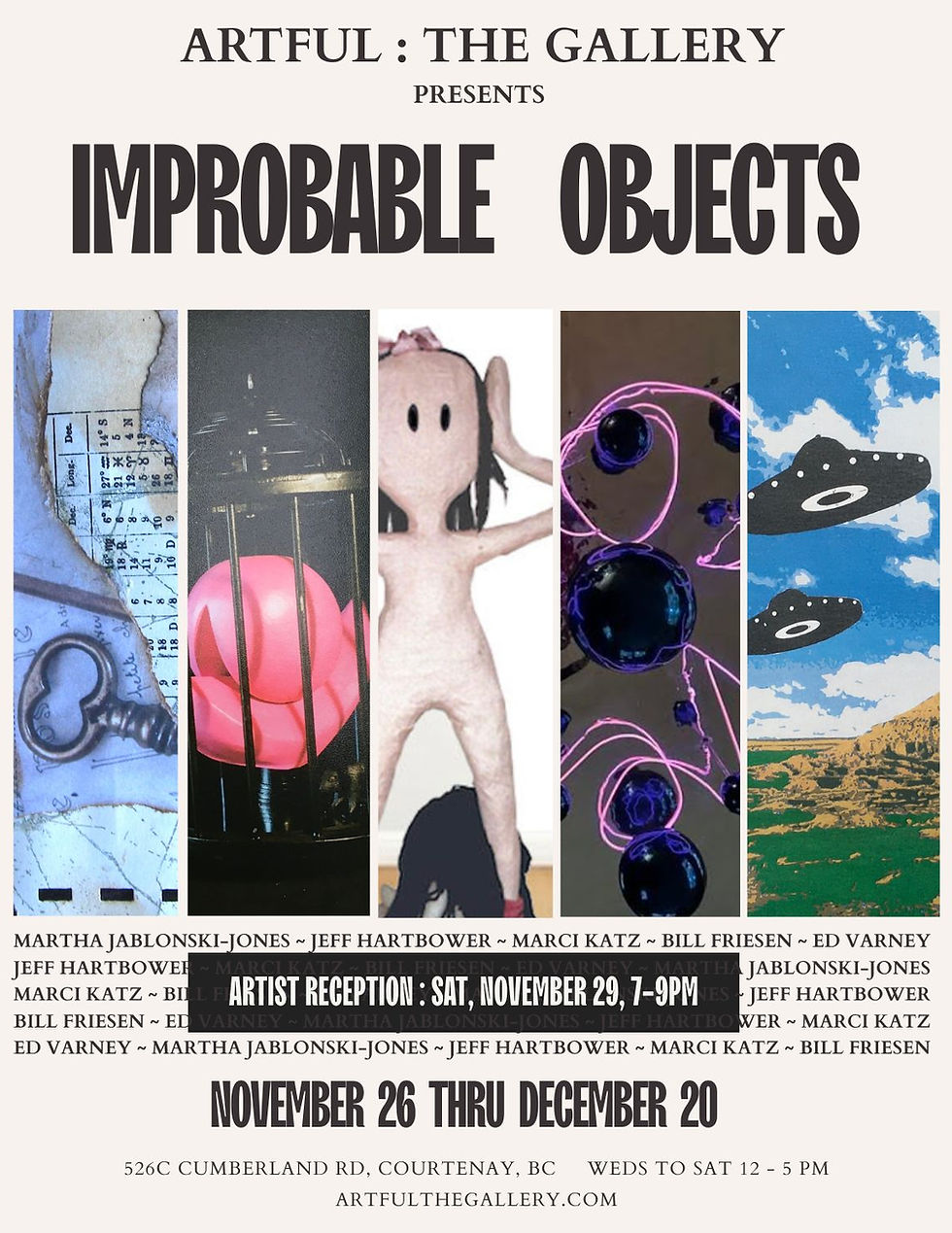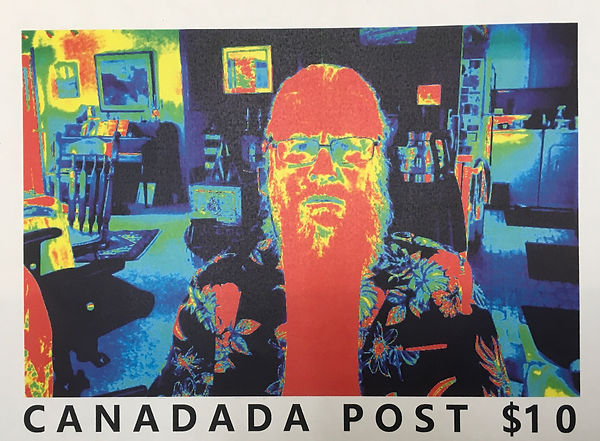Opens November 26th and runs through December 20th!

Join us for the artist reception!
Saturday, November 29, 7-9pm
Improbable Objects
Five pillars of the Comox Valley Art scene are collaborating to bring their varied artistic endeavours to Artful : The Gallery with the exhibition “Improbable Objects”. Collaborating for inspiration has always been a productive creative strategy, and this exhibition reflects the varied sensibilities of the artists: Ed Varney, Marci Katz, Martha Jablonski-Jones, Jeff Hartbower and Bill Friesen.
The absurdity and illogical scenes of Surrealism and Dadaism led the to the overall theme for this exhibition. From there, each artist followed their own creative path into the dreamlike imagery. The broad variety of artistic expression utilized by this group of artists includes printmaking, collage, painting, sculpture, drawings, paintings and contributes to the unexpected juxtapositions created by their artworks. The result is a playful exhibition of contrasts with bizarre and uncanny combinations to stimulate the unconscious; the ultimate source of creative freedom.
"Improbable Objects" runs at Artful : The Gallery November 26 thru December 20. Join us for the Artist Reception, Saturday, November 29th, 7-9 pm. Regular gallery hours are Weds to Sat, 12-5pm. The gallery is located at 526C Cumberland Rd, in Courtenay.
The Artists:

Ed Varney
If you know, you know.
Marci Katz
Marci Katz was born in Victoria, and grew up in Vancouver. She graduated from UBC in the 1960’s, got married and moved to Ontario, where she had her two wonderful, amazing children. While there, she became qualified in graphic design and worked
freelance as a designer. Katz also took instruction in the classic French style of charcoal drawing, which she took to immediately. She has taught courses in design, silkscreen printmaking, and visual language.
In 1991, she left married life and Ontario and returned to the Island.
Katz has always drawn. Initially she used charcoal willow sticks exclusively, and later experimented with coloured inks and pastels, alone or in combination. She's done some three-dimensional work, using paper mache, fabric, or creating assemblage work from found materials.

Katz now works mostly with mixed media, combining traditional media with digital and other techniques, including collage and text. Her subject matter largely bubbles up from within herself, and she goes wherever it takes her. Katz enjoys exhibiting, both solo and collaboratively, either with her partner, sculptor Bill Friesen, or with close friends, especially those in this current exhibition.
She shares that she has faced some challenges in her life, and is constantly surprised and grateful to find that she's survived it all, and has ended up - improbably - in a place she loves, making work she enjoys, blessed with a home, a partner, children, (now
grown) and close, enduring friendships.

Martha
Jablonski-Jones
After studying Fine Arts at the University of Alberta, Martha Jablonski-Jones spent several years in illustration and graphic design, working mainly in pen and ink. But painting always
called to her, and eventually she gave it her full attention.As her commitment grew, she relocated to a live/work studio in east Vancouver to focus on the surrounding urban landscape, especially the alleys, with their rich patina of wear and tear. The companionship of other artists was a great motivation for creativity and personal progress. Later on, some time spent in Texas infused
her with a recharged love of colour, as well as an interest in vintage and ‘roots’ themes which then appeared in her work.
For the past two years, Jablonski-Jones has been working in collage, creating mixed media art journals, emphasizing visual and graphic elements of line, colour, and pattern, and incorporating textiles and found objects. These journals often deal with more
speculative and inner themes, while retaining her fondness for the textures of things old and worn. Over the last 20 years, she has shown in venues in and around Vancouver and Vancouver Island, and currently works from her Courtenay home.
Jeff Hartbower

If, as she said, “there is no
there there,”
we migrate elsewhere
and there is where we nest
this is the spot where we stop
our random darting about
the spot we line with shredded print
haunted debris and memory
the spot where we perch on the edge
to sing our last spring
and fall out to ground
where the cat is
After University (BA, San Francisco State University) Jeff Hartbower graduated to the BC Coast. He logged, he fished commercially, built furniture and worked in boat yards for the greater part of the next 30 years. He skippered the Fisheries Patrol vessel “Gull Rock” on Quatsino Sound in the late 1970’s and worked for the City of Vancouver as a bylaw officer in the late 80’s. He and his wife, Jo Swallow, salvaged and rebuilt a classic sailboat which they lived aboard in the early 90’s. They settled ashore in Courtenay, after living briefly in Sointula and Cumberland.
Hartbower works in a folk tradition and uses the skills and craftsmanship of the boat builder and furniture maker. Although primarily a woodcarver, he uses whatever materials are at hand. The sculptures are political and satirical and local and historical in theme. He was a prize winner in the 2002 Campbell River Chain Saw Carving Competition. he and Jo received the inaugural Nonny Milne Award for Outstanding Contribution to the Arts in 2015.
About art he says: Some is such sweet
anarchy
Such a lovely other than
Such a good smell
Makes you blink
and stand on your toes
This is certainly
curiously
So.

Bill Friesen
Bill Friesen was born to a working class family in Winnipeg, Manitoba, and lived there until moving to Vancouver Island in 1993. His father worked for the Canadian National Railway, where he was a union leader, and his mother was a stay-at-
home mother. He has three siblings, two brothers now living on the Island, and a sister still in Winnipeg. Their childhood home life was dysfunctional and chaotic, and he avoided much of it
by spending a lot of time in his room drawing and sculpting simple figures from plasticine. On Sundays his grandmother who lived with them, would invite Friesen into her room to listen to the BBC on the radio, where they interviewed famous artists.
She encouraged Friesen to keep drawing, and he did spend a lot of time drawing while in grade school, but once in Junior High his interest turned to sports. It wasn’t until his mid-twenties that his interest in art was rekindled. Friesen started carving animal figures in wood and soft stone. It wasn’t long before he found that he could sell his work, and it became a side hustle to the jobs he had at the time.
Eventually Friesen joined the Winnipeg police force, and worked for most of his career as an intelligence officer. He got involved with drawing portraits of criminal suspects, and at some point decided he should go to the Universityof Manitoba to study fine arts. Friesen completed a BFA Honours program there while continuing his career with the police. After graduating, he participated in several art shows In Manitoba, Minnesota, and other locations.
Friesen moved to Vancouver Island in 1993, and was president of the Oceanside Arts Council Gallery in Parksville for several years, and is a lifetime member there. Since moving to the Island IFriesen has exhibited in Vancouver, Victoria, Duncan, Parksville, Qualicum Beach, Cumberland, Courtenay and Campbell River. He has taught workshops in metal casting, mold making, sculpture, puppetry, and worked on several joint art projects, often with his partner Marci Katz.

